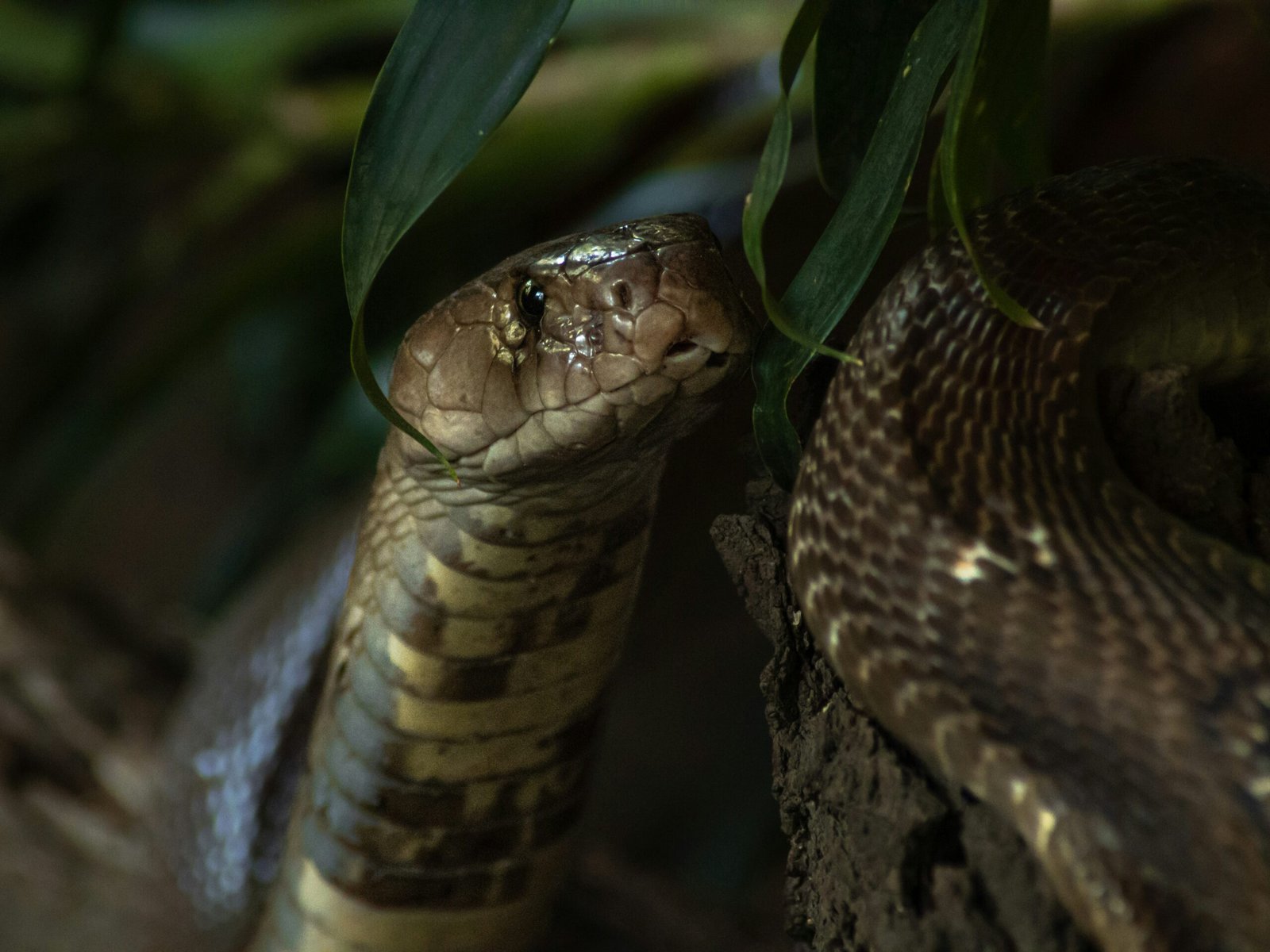
Introduction to Genus Bungarus
The genus Bungarus, commonly referred to as kraits, is a group of highly venomous snakes found primarily in South and Southeast Asia. This genus falls within the family Elapidae, which also includes cobras, mambas, and coral snakes. Kraits are renowned for their potent neurotoxic venom, which can cause severe health complications in humans and other animals. Understanding the life cycle of these reptiles is crucial for both ecological studies and medical research.
Members of the genus Bungarus exhibit distinctive characteristics that set them apart from other snakes. They typically have smooth, shiny scales and are adorned with striking patterns, often featuring alternating bands of black and white or yellow. Kraits are nocturnal and are most active during the night, which contributes to their enigmatic nature. During the day, they often hide in burrows, under rocks, or within dense vegetation.
Kraits are predominantly found in a range of habitats, including forests, grasslands, and even agricultural fields. Their geographical distribution spans across countries such as India, Sri Lanka, Bangladesh, Nepal, and parts of Southeast Asia, including Thailand, Vietnam, and Indonesia. The adaptability of these snakes to various environments is a testament to their evolutionary success.
Within the genus Bungarus, several species are noteworthy due to their unique behaviors and ecological roles. Common species include the Indian krait (Bungarus caeruleus), the banded krait (Bungarus fasciatus), and the Malayan krait (Bungarus candidus). Each of these species plays a significant role in controlling the population of small mammals and other prey, thus maintaining ecological balance.
The significance of kraits in their respective ecosystems cannot be overstated. They serve as both predators and prey, contributing to the intricate web of life. Moreover, their venom has been a subject of extensive research, leading to advances in antivenom development and a better understanding of neurotoxins. As we delve deeper into the life cycle of these fascinating reptiles, the insights gained can enhance our appreciation and knowledge of their ecological importance.
Egg Laying and Incubation
The reproductive behavior of Bungarus species, commonly known as kraits, is a fascinating aspect of their life cycle. These snakes exhibit oviparous reproduction, meaning they lay eggs rather than giving live birth. The breeding season for most Bungarus species typically occurs during the warmer months, often coinciding with the onset of the monsoon. Female kraits seek out suitable nesting sites, which usually include underground burrows, decaying vegetation, or other secluded and humid areas that offer protection from predators and environmental extremes.
Once a suitable location is identified, the female lays a clutch of eggs. The number of eggs laid can vary significantly among different species within the Bungarus genus, generally ranging from 4 to 14 eggs per clutch. The eggs are oval and leathery, allowing for gas exchange while retaining moisture. The conditions required for successful egg incubation are critical and must be carefully maintained. Optimal incubation temperatures for Bungarus eggs typically range between 28°C to 30°C (82°F to 86°F), with a relative humidity of about 70-80%. These conditions are crucial for embryonic development and successful hatching.
Unlike some other reptilian species, Bungarus parents do not exhibit extensive parental care post-oviposition. Once the eggs are laid, the female krait’s involvement generally ceases. The incubation period for Bungarus eggs spans approximately 60 to 80 days, depending on the ambient temperature and humidity levels. During this time, the eggs remain vulnerable to environmental fluctuations and potential predators. The hatchlings emerge fully developed and are immediately independent, possessing the innate ability to hunt and fend for themselves.
Understanding the egg-laying and incubation practices of Bungarus species provides valuable insights into their life cycle and reproductive strategies. This knowledge is essential for conservation efforts, particularly for species that are threatened or endangered, as it helps in creating and maintaining environments that support their breeding and population sustainability.
Hatching and Early Life
The genus Bungarus, commonly known as kraits, undergoes a fascinating hatching process that marks the beginning of their life cycle. The eggs of Bungarus snakes are typically laid in concealed, humid environments to ensure optimal incubation conditions. After an incubation period ranging from 60 to 80 days, the hatchlings, equipped with an egg tooth, break through the leathery shells of their eggs. This initial act of hatching is crucial as it sets the stage for their early life.
Upon emerging, Bungarus hatchlings exhibit distinct physical characteristics that set them apart from adults. They are notably smaller, with an average length of 25 to 35 centimeters. The coloration of the hatchlings is generally more vivid compared to adults, featuring pronounced bands that serve as a form of camouflage against predators. This early coloration and patterning are essential for their survival, blending seamlessly with the surrounding environment.
In their early life, Bungarus hatchlings display specific behaviors aimed at ensuring their survival. They are relatively reclusive, often seeking shelter under leaf litter, logs, or in burrows to avoid predation. This period of seclusion is critical as it allows them to grow and develop without the immediate threat of predators. Additionally, these hatchlings exhibit nocturnal behavior, being most active during the night when they hunt for prey.
The initial feeding habits of Bungarus hatchlings are vital for their growth and development. They primarily feed on small reptiles, amphibians, and invertebrates. Their diet includes small lizards, frogs, and occasionally young snakes. The hatchlings rely on their keen sense of smell and the ability to detect heat to locate prey. This period of early feeding is crucial as it provides the necessary nutrients for rapid growth and development.
Overall, the hatching and early life of Bungarus snakes involve a series of well-adapted strategies and behaviors that ensure their survival and successful transition into adulthood. From their initial emergence from the eggs to their nocturnal hunting habits, these early stages lay the foundation for the development of these fascinating reptiles.
Juvenile Development
The juvenile phase of Genus Bungarus, commonly known as kraits, is a critical period characterized by significant growth and development. During this stage, krait juveniles undergo several size changes, molting processes, and dietary shifts that prepare them for adulthood. Initially, juvenile kraits are relatively small, typically measuring around 20-30 centimeters in length. However, as they progress through their juvenile stage, they experience rapid growth, often doubling or tripling in size within the first few months.
Molting is a crucial aspect of juvenile development in Bungarus. This process involves the shedding of their outer skin layer, which allows for continued growth. Juvenile kraits molt more frequently than adults, undergoing this process approximately every 4-6 weeks. The frequency of molting decreases as they mature, with adults molting only a few times a year. Molting not only facilitates physical growth but also helps eliminate parasites and repair damaged skin.
Dietary shifts are notable during the juvenile stage. Juvenile kraits primarily feed on smaller prey items such as insects, small amphibians, and other invertebrates. As they grow, their dietary preferences expand to include larger prey, such as small rodents and other reptiles. This shift in diet is essential for supporting their increasing energy demands and promoting healthy growth.
The duration of the juvenile stage in Bungarus varies depending on environmental factors. Typically, this stage lasts between 1-2 years, but it can be influenced by factors such as temperature, humidity, and availability of food resources. Warmer temperatures and abundant food sources generally accelerate growth, while cooler temperatures and scarce food can prolong the juvenile phase.
Environmental conditions play a significant role in the development of juvenile kraits. Optimal habitats with stable temperatures, sufficient humidity, and plentiful prey contribute to healthier and faster-growing juveniles. Conversely, suboptimal conditions can lead to stunted growth and increased vulnerability to predators and diseases.
Maturation and Adult Life
The transition from juvenile to adult Bungarus, commonly known as kraits, is marked by significant physical and behavioral changes. Juvenile kraits initially exhibit more vibrant coloration and banding patterns, which may fade or alter as they mature. During this maturation phase, which typically spans a few years, kraits grow in size and their venom potency increases, enhancing their hunting efficiency.
Adult kraits exhibit distinctive behaviors when compared to their juvenile counterparts. They become more reclusive and nocturnal, opting to hunt under the cover of darkness. This shift not only maximizes their hunting success but also minimizes their exposure to potential predators. The diet of adult Bungarus primarily consists of small mammals, other reptiles, and even other snakes, including smaller kraits. This diverse diet is facilitated by their highly potent neurotoxic venom, which immobilizes prey rapidly, allowing for easier consumption.
The hunting strategies of mature kraits are both methodical and opportunistic. They rely heavily on their keen sense of smell and sensitivity to vibrations to locate prey. Once a target is identified, the krait strikes with precision, delivering venom through its hollow fangs. The neurotoxin quickly incapacitates the prey, ensuring minimal struggle. This efficiency in hunting is crucial for their survival and energy conservation.
In the ecosystem, adult kraits play a pivotal role as apex predators. Their presence helps to regulate the populations of their prey species, thereby maintaining a balanced ecosystem. By controlling the numbers of small mammals and other reptiles, kraits indirectly influence the vegetation dynamics and the overall health of their habitat. Moreover, their predation on other venomous snakes reduces competition and potential threats within their territory.
Understanding the maturation and adult life of Bungarus is essential for appreciating their ecological significance and the intricate balance they help to maintain in their natural habitats. Their evolution into adept hunters and vital ecosystem components underscores the complexity and adaptability of this fascinating genus.
Reproductive Behavior
The reproductive behavior of Genus Bungarus, commonly known as kraits, is a fascinating aspect of their life cycle. These elusive snakes exhibit specific mating behaviors and reproductive cycles that are critical for their survival in the wild. The attraction of mates in Bungarus species typically involves pheromonal communication, wherein females release chemical signals to indicate their readiness for mating. These pheromones play a vital role in ensuring that males can locate and identify receptive females within their territory.
During the mating season, which generally occurs during the warmer months of the year, male kraits become more active and engage in intricate courtship rituals to win the favor of potential mates. This period of heightened activity is marked by increased movement and interaction between individuals. Courtship behaviors among Bungarus species may include tactile and visual displays, where males gently nudge and coil around females in a display of affection and dominance. These rituals are crucial as they allow the snakes to establish compatibility and readiness for copulation.
Once courtship is successful, copulation occurs, which involves the male aligning his body alongside the female and using his hemipenes to transfer sperm. The reproductive strategies of Bungarus are adapted to their specific environmental conditions. For instance, some species exhibit delayed fertilization, where the female can store sperm for several months before fertilizing her eggs. This strategy ensures that offspring are produced during favorable environmental conditions, thereby increasing their chances of survival.
Post-mating, female kraits lay eggs in concealed and secure locations such as burrows or under debris. The number of eggs laid can vary, but it typically ranges from 6 to 15. The incubation period lasts several weeks, during which the eggs are left unattended. Upon hatching, the young kraits are fully independent and receive no further parental care. These reproductive behaviors and strategies are essential for the perpetuation of the species, ensuring that new generations of kraits continue to thrive in their natural habitats.
Lifespan and Longevity
The Bungarus genus, commonly known as kraits, exhibits a fascinating lifespan that varies significantly between individuals in the wild and those in captivity. Typically, kraits in their natural habitats have a lifespan that ranges from 10 to 15 years. However, several factors can influence this longevity, including predation, diseases, and the environmental conditions they are exposed to.
In the wild, predation is a significant threat to Bungarus snakes. Natural predators such as birds of prey, larger snakes, and certain mammals pose a constant danger. Additionally, young kraits are particularly vulnerable during their first year of life, and many do not survive to adulthood. Diseases also play a critical role in their lifespan. Parasitic infections, bacterial and viral diseases can all shorten the life of a krait. The environmental conditions, including availability of prey, habitat quality, and climate, further impact their longevity. Harsh environmental conditions or habitat destruction can greatly reduce their lifespan.
In captivity, Bungarus snakes often enjoy a longer lifespan due to the controlled environment and absence of predators. With proper care, a krait can live up to 20 years or more. Captive kraits benefit from a consistent diet, regular health check-ups, and a stable habitat, which significantly enhances their longevity. The oldest recorded krait in captivity lived to be around 25 years old, showcasing the potential for extended life under optimal conditions.
Overall, the life expectancy of Bungarus snakes is heavily influenced by external factors. While wild kraits face numerous challenges that can limit their lifespan, those in captivity can thrive for many years with appropriate care. Understanding these factors is crucial for both conservation efforts and the maintenance of kraits in captivity, aiming to ensure their survival and well-being.
Conservation and Threats
The genus Bungarus, commonly known as kraits, faces significant conservation challenges. These species are listed under various conservation statuses depending on their geographical distribution and population trends. A primary concern for Bungarus species is habitat destruction. Rapid urbanization, deforestation, and agricultural expansion have led to the fragmentation and loss of their natural habitats. This habitat destruction reduces the available territory for kraits to hunt, reproduce, and seek refuge, thereby threatening their survival.
Human impacts further exacerbate the risks to Bungarus populations. Encroachment into snake habitats often leads to increased human-snake interactions, which can result in the killing of these snakes out of fear or misunderstanding. Additionally, road mortality is a significant threat, as many kraits fall victim to vehicular traffic while crossing roads in search of food or mates.
Environmental factors also play a critical role in the endangerment of Bungarus species. Climate change, with its associated extreme weather events and shifting temperature patterns, can alter the ecosystems that kraits depend on. Changes in prey availability and water sources, combined with the effects of pollution, further stress these snake populations.
Conservation efforts for Bungarus species are multifaceted. Protective legislation and the establishment of wildlife reserves are essential strategies to safeguard their habitats. In regions where kraits are known to inhabit, creating protected areas can provide a sanctuary free from human encroachment and habitat destruction. Additionally, public education campaigns are crucial to dispel myths and reduce the fear associated with these snakes, promoting coexistence and reducing the incidence of human-snake conflict.
Research and monitoring are also vital components of conservation strategies. By understanding the population dynamics, habitat requirements, and threats facing Bungarus species, conservationists can develop more effective management plans. Conservation organizations and government agencies must collaborate to implement these strategies and ensure the long-term survival of Bungarus species in the wild.

















+ There are no comments
Add yours